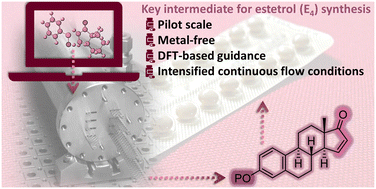Metal-free synthesis of an estetrol key intermediate under intensified continuous flow conditions†
Abstract
Estetrol is a natural biogenic estrogen with a promising future in hormonal-dependent treatments and growing established markets for oral contraception. Approved in 2021 by the European Medicines Agency (EMA) and the US Food and Drug Administration (FDA) in combination with drospirenone as the fifth generation of combined oral contraceptive pills, efforts toward cost-efficient and intensified large-scale synthesis are therefore required to meet a rapidly increasing demand worldwide. Herein we present a study aiming at the intensified preparation of a key enone intermediate for the preparation of estetrol. This approach relies on a unique methodology, where preliminary computational data guided the framework for experimental design and assess the feasibility under flow conditions, hence significantly reducing the amount of unguided experimental work. Chemical and chemical engineering innovations rely on the thermolysis of a key sulfoxide derivative of estrone, the elimination of which was carefully tailored for minimizing side-product formation and for improving robustness and productivity. Upon optimization, the thermolysis process was amenable to pilot production, leading to an unprecedented space–time yield of 1.13 kg L−1 h−1. With these metrics transposed to the entire production scheme toward estetrol, a forecast of several millions of doses (15 mg formulation) is therefore achievable with a minimal overall footprint.



 Please wait while we load your content...
Please wait while we load your content...